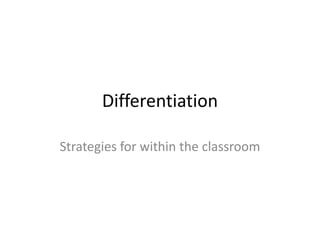
Differentiation powerpoint
- 1. Differentiation Strategies for within the classroom
- 2. Why differentiation. Share some good examples of well differentiated lessons. Brainstorm different strategies for differentiation. Learning styles Difficulties with differentiation Plan a lesson.
- 3. Definitions of differentiation All students are different in terms of their achievement, ability, learning and cognitive styles as well as attitudes, pace of learning, personality and motivation. It means starting where the kids are rather than adopting a standardized approach to teaching that seems to presume that all learners of a given age or grade are essentially alike. Thus differentiated instruction is “responsive” teaching rather than “one-size-fits-all” teaching A fuller definition of differentiated instruction is that a teacher proactively plans varied approaches to what students need to learn, how they will learn it, and/or how they can express what they have learned in order to increase the likelihood that each student will learn as much as he or she can as efficiently as possible. (Tomlinson, 2003, p. 151)
- 4. A well differentiated lesson
- 5. Learning styles Visual learn through seeing. Auditory learn through listening. Kinaesthetic learn through , moving, doing and touching. Which is your primary learning style? Can we assess the children to discover their preferred learning style? Knowing your children Can we give children the opportunities to work in their preferred style?
- 6. Multiple intelligences Dr. Howard Gardner developed the theory of multiple intelligences in 1983 eight different ways in which a student might learn. These are extensions of the three recognized learning styles; audio, visual and tactile/kinesthetic. Including all eight in each lesson can be difficult, but varying lesson activities throughout the curriculum makes it easier for all students to learn. Linguistic intelligence represents a strength in learning through words. These students succeed in a traditional classroom due to their ability to do well in verbal environments that emphasize listening, speaking and writing. Logical-Mathematical intelligence represents a strength in logical reasoning. These students do well with problem solving activities, can easily make connections between different pieces of information and tend to be comfortable asking questions. Bodily-Kinesthetic intelligence is represented by students who learn best by working with the space around them. In school, many of these children find success in athletics, acting and art. Interpersonal intelligence is the ability to relate well with others. These are the students who learn best by working with others, and may be very in-tune with, and affected by, the emotions and feelings of their peers. Intrapersonal intelligence is a strength in self-reflection and self-awareness. Students who learn best through intrapersonal activities tend to prefer self work over group work and do well in philosophical exercises. Musical intelligence is learning through rhythm, music and hearing. These students think in patterns and are attracted to musical connections to lessons. Naturalistic intelligence was not one of the original set, but was identified by Gardner in 1997. These students may be affected by weather, easily able to nurture and relate to plants and animals, and frequently need to make connections to previous learning to understand something new. Visual-Spatial intelligence is represented by students who learn best through images. They tend to think in pictures, are artistic and do well when problem solving with manipulatives.
- 7. How many ways can we differentiate our teaching? Same Activity – Different Tasks Quantity Level of difficulty Grouping Same task but through a choice of activities – each activity appealing to a different learning style allowing students to choose an end product to a project that fits their skills, such as choosing to create a poster, write an essay or compose a song. Same learning objective through a different task When children are presented information in a way they understand and then can work with it using their strengths in order to master the material they are more likely to be motivated to succeed. Same ability Mixed ability Learning styles It is important to vary ways to present the content of the lesson, so that at some point in the class, each child would receive the lesson in a format through which he or she learns best. CONTENT What PROCESS How PRODUCT Evaluation
- 8. Difficulties with Differentiation Particular subjects Particular children Time Resources